At first glance, there doesn’t seem much to Muang La. Therein of course lies its charms. Being right in the heart of a small community, Vincent Vichit-Vadakan gains insights into local life.
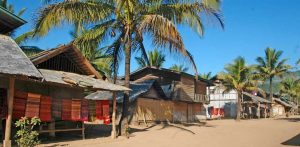 My first morning I went for a long walk around the town. I stopped to see a family drying jungle cardamom, mostly for export to nearby China, on my way to visit the Khmu village of Muang La. One of the things that makes Oudomxay unique is the ethnic make-up of the province. Unlike the rest of Laos where Lao Loum (or “lowland” Lao) are the majority, the population here is mostly Khmu (at least 60 per cent), while Lao Loum are only about 25 per cent and ethnic Hmong (who originated in China) and other smaller groups make up the rest of the population. Though some have also converted to Buddhism, Khmu also maintain their animist beliefs, like the totems and charms attached to the outside of their bamboo houses. As you walk around the village, you can talk to people cooking, weaving, carving and going about their daily lives. A guide makes communication much easier, but failing that, body language, good will and a big smile go a long way.
My first morning I went for a long walk around the town. I stopped to see a family drying jungle cardamom, mostly for export to nearby China, on my way to visit the Khmu village of Muang La. One of the things that makes Oudomxay unique is the ethnic make-up of the province. Unlike the rest of Laos where Lao Loum (or “lowland” Lao) are the majority, the population here is mostly Khmu (at least 60 per cent), while Lao Loum are only about 25 per cent and ethnic Hmong (who originated in China) and other smaller groups make up the rest of the population. Though some have also converted to Buddhism, Khmu also maintain their animist beliefs, like the totems and charms attached to the outside of their bamboo houses. As you walk around the village, you can talk to people cooking, weaving, carving and going about their daily lives. A guide makes communication much easier, but failing that, body language, good will and a big smile go a long way.
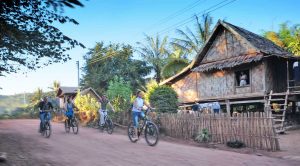 From the village, you can cross back to town on a bamboo raft. When we landed, we discovered a brand new (as yet nameless) open-air kitchen had just opened, catering to daytrippers from the provincial capital Muang Xay, about an hour away. (Muang Xay is also the location of Oudomxay airport, the easiest way to access Muang La.) We asked what was on the menu and were rewarded with a delicious stir-fry of tender local venison and a clear fragrant soup of simmered buffalo pizzle and jungle greens, prized for its, er, restorative qualities, particularly for male diners. Less adventurous diners will also find freshwater fish, buffalo steaks, chicken and pork cooked to order. Meals are enjoyed around a low table in a sala, or shaded gazebos.
From the village, you can cross back to town on a bamboo raft. When we landed, we discovered a brand new (as yet nameless) open-air kitchen had just opened, catering to daytrippers from the provincial capital Muang Xay, about an hour away. (Muang Xay is also the location of Oudomxay airport, the easiest way to access Muang La.) We asked what was on the menu and were rewarded with a delicious stir-fry of tender local venison and a clear fragrant soup of simmered buffalo pizzle and jungle greens, prized for its, er, restorative qualities, particularly for male diners. Less adventurous diners will also find freshwater fish, buffalo steaks, chicken and pork cooked to order. Meals are enjoyed around a low table in a sala, or shaded gazebos.
Another more physical walk takes you into the hills for some truly jaw-dropping vistas over rice paddies and fish farms, an opportunity to observe the bounty of the jungle first hand. Of course there are wild leaves and mushrooms for the picking, but what I didn’t realise was that resourceful locals also cultivate plots in the middle of the jungle, either because their own lands are too small or because the soil is better suited to growing certain crops. The steep paths were muddy, and occasionally mined with massive buffalo droppings. At a certain points my guide Seechun had to hack our way through with a machete. I wish I’d been given my own, though the risk would of inadvertently chopping into someone’s farm would have been high.
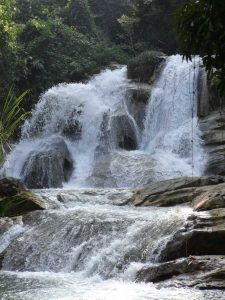 Muang La is also an ideal place to partake in tak bat or almsgiving. Whether or not you are participating in the ceremony, dress modestly. Especially for women, keep your head lower (by kneeling or sitting on a low stool), do not look the monks in the eye, and do not touch them. If you’re not giving, you can take pictures but keep a respectful distance.
Muang La is also an ideal place to partake in tak bat or almsgiving. Whether or not you are participating in the ceremony, dress modestly. Especially for women, keep your head lower (by kneeling or sitting on a low stool), do not look the monks in the eye, and do not touch them. If you’re not giving, you can take pictures but keep a respectful distance.
One of the best ways to intercept the sunrise procession is to wait by the town market. Offerings like sticky rice will be available for purchase. To see the market in full swing you have to wake up early anyway so it makes sense to combine the procession with a market tour. Boiled hops and microscopic chestnuts, fried rice cakes, buffalo skin crackling, buffalo jerky and baby mandarine oranges were just a few of the snacks I enjoyed. Vendors sell everything from charcoal stoves to textiles and there is also an official handicrafts shop.
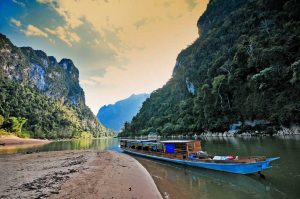 As you wander back, you can visit Wat Pha Sing Kham, the town’s only temple. Legend has it that the four centuries ago the sacred Buddha image was being transported by river when it broke away and chose this branch of the Nam Pak (literally “where the water separates”). Locals brought it up the hill, built a shrine and converted to Buddhism.
As you wander back, you can visit Wat Pha Sing Kham, the town’s only temple. Legend has it that the four centuries ago the sacred Buddha image was being transported by river when it broke away and chose this branch of the Nam Pak (literally “where the water separates”). Locals brought it up the hill, built a shrine and converted to Buddhism.
I checked into Muang La Lodge, a charming property in the middle of the village. Ten rooms surround a small lush garden, each with furnishings inspired by French colonial times and local arts, parquet floors and balconies that look out over the river or the garden as well as additional seating on the ground floor of the stilted villas. The hotel prides itself on the absence of televisions and landlines (though on arrival you’re given a mobile phone with direct access to the English-speaking staff for any needs). Recently the hotel gave in to requests for in-room wifi, so you can now easily post your idyllic holiday pictures.
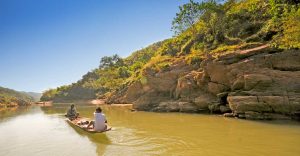
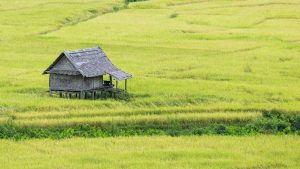

Crossing a wooden rope bridge, you reach a private island in the middle of the river where the hotel’s pool and poolside bar are located. I loved the hotel’s private sala, an observation tower that is perfect for taking in the sunset while sipping a pre-dinner kir, the classic French apéritif of white wine and black currant liqueur.
The hotel was built overlooking the village hot springs. Pools were built for the villagers who come to bathe and play every evening. The warm water is believed to have therapeutic properties. Guests are welcome to use the public pools at any time, but for a more exclusive experience I started every evening with a moonlight soak in one of the two hot tubs on the property that are filled daily with the same hot spring water. What cinched it for me? The hot tubs are located at the top of four-metre high towers, bringing you that much closer to the stars. It left me relaxed for my leisurely French-Lao fusion dinner.
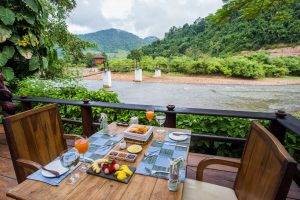

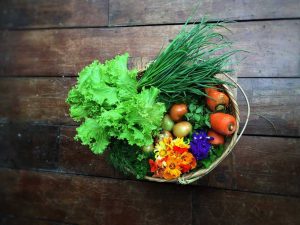
Muang La Lodge’s formula is inclusive of breakfast and dinner and requires a minimum two-night booking. Knowledgeable guides to accompany around the village are also included. They are also available to take you on mountain treks, to nearby villages and for other activities of your choosing.
Getting There:
Lao Airlines offers twice daily return services between Vientiane
and Oudomxay Airport, take abus for one hour bus ride from
there to Muang La Lodge or book a pick-up service in advance.
Contact:
resa@muanglao.com
+856 21 243 446
by: VINCENT VICHITH-VADAKAN



 ລາວ
ລາວ
